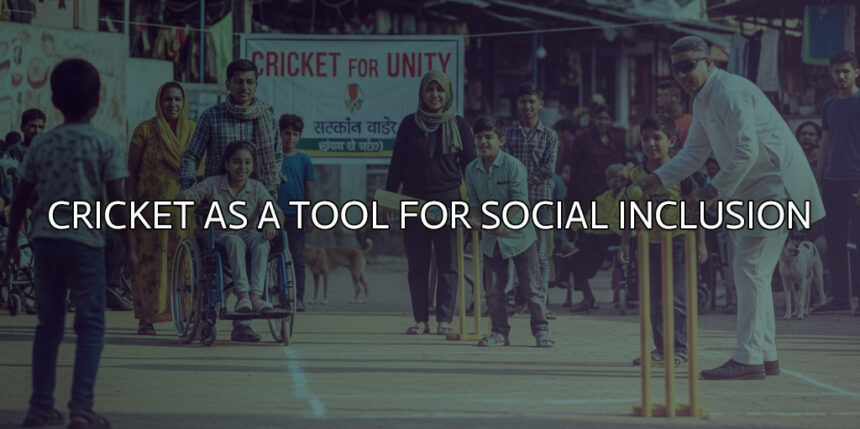Cricket is more than just a sport in many parts of the world—especially across South Asia, Africa, the Caribbean, and parts of Europe and Australia. It is a shared passion that transcends language, religion, and socioeconomic status. In underprivileged areas, where opportunities are often limited and divisions deeply rooted, cricket emerges as a powerful tool for social inclusion.
Whether played in dusty alleys, schoolyards, or refugee camps, cricket creates a sense of community and belonging. It offers young people a platform to express themselves, learn teamwork, and develop confidence. More importantly, it brings together individuals from different backgrounds, challenging stereotypes and building bridges across cultural and class divides.
Online platforms like Bet Raja reflect the widespread popularity of cricket, showing how the sport connects fans and communities across borders—both on the ground and in the digital arena.
This article explores how cricket has become a unifying force in underprivileged communities—highlighting real-life stories, grassroots initiatives, and the profound social change driven by a simple bat and ball.
The Power of the Pitch – Why Cricket Works
Cricket holds a unique place in the hearts of millions because of its accessibility, flexibility, and cultural relevance. Unlike many sports that require expensive gear or formal training facilities, cricket can be played with minimal equipment—sometimes just a stick and a ball on any open ground. This simplicity makes it incredibly adaptable, especially in under-resourced environments.
But beyond the ease of play, cricket fosters values that are essential for social inclusion: teamwork, respect, discipline, and patience. Every match requires collaboration across roles—batters, bowlers, fielders, and captains—making it a natural space for learning cooperation and building mutual respect.
Stories of Change – Voices from the Margins
Behind every cricket bat swung in a dusty alley or every boundary cheered in a refugee camp lies a story of hope, resilience, and transformation. Cricket has not only provided a game—it has created pathways for education, leadership, and unity among some of the world’s most marginalized populations.
- Mumbai’s Dharavi: Where Dreams Take Guard: In one of Asia’s largest slums, children grow up in cramped conditions with limited access to formal education or safe recreational spaces. Yet in the heart of Dharavi, cricket is everywhere. Local NGOs like Reality Gives have harnessed the game to engage at-risk youth, using cricket as a bridge to life skills, mentorship, and academic support.
- Rwanda: Healing After Genocide: Following the 1994 genocide, Rwanda turned to sport for healing. Cricket, introduced by returning refugees from Uganda, soon became a vehicle for unity. Young Rwandans—many orphaned or displaced—found common ground through the game. The Rwanda Cricket Stadium Foundation now supports gender-inclusive programs that use cricket to foster peace, reconciliation, and leadership development among youth.
- Afghanistan: Cricket as Refuge and Pride: Afghan refugees in Pakistan learned the sport while living in camps. Many brought it home when they returned, including stars like Rashid Khan and Mohammad Nabi. Today, cricket is a national passion—and one of the few unifying forces across ethnic and political lines.
Initiatives Making a Difference
Around the world, numerous grassroots organizations, NGOs, and community leaders are using cricket as a catalyst for inclusion, empowerment, and education. These initiatives go beyond just teaching how to play—they’re building stronger, more connected communities from the ground up.
- Chance to Shine (UK): Founded in 2005, Chance to Shine has brought cricket to over six million children across the UK, many from disadvantaged or immigrant backgrounds. Through school and street programs, they use cricket to develop teamwork, resilience, and communication skills.
- Cricket Without Boundaries (Global): This volunteer-led charity operates in Africa and Asia, using cricket to promote health education, particularly around HIV/AIDS awareness. Coaches blend cricket drills with life-saving messages, making sport a powerful educational tool.
- Magic Bus (India): Magic Bus uses a sport-based curriculum—including cricket—to mentor children living in poverty. Their goal is to move children from childhood to livelihood by combining play with education, gender equality training, and career guidance.
- The Rwanda Cricket Stadium Foundation (Rwanda): More than just a place to play, Rwanda’s first international-standard cricket stadium serves as a community hub.
Social Integration in Action
Cricket doesn’t just entertain—it connects. In some of the most divided or marginalized communities, the sport becomes a shared language, breaking down barriers of caste, class, gender, religion, and nationality. Through structured programs and spontaneous play alike, cricket creates moments of unity that ripple far beyond the pitch.
Bridging Caste Divides in Rural India
In many rural parts of India, caste discrimination still limits social interaction. But on the cricket field, a Dalit bowler and an upper-caste batsman must communicate, coordinate, and respect each other’s roles. Local tournaments often create rare spaces where caste boundaries blur. NGOs working in states like Bihar and Uttar Pradesh report that these interactions have opened doors to dialogue and mutual respect, both on and off the field.
Cricket in Refugee Camps
In camps across Jordan, Bangladesh, and Kenya, cricket offers displaced children and youth a rare sense of normalcy. Whether it’s Rohingya refugees in Cox’s Bazar or Syrian children in Za’atari, cricket gives young people structure, purpose, and community. Playing together helps build friendships between ethnic groups that might otherwise remain isolated or distrustful.
Fostering Interfaith Unity in Pakistan
In cities like Karachi and Lahore, cricket leagues have been organized to include players from Muslim, Christian, Hindu, and Sikh communities. These tournaments are more than just games—they’re celebrations of coexistence. Stories have emerged of friendships forming across religious lines, challenging prejudice and promoting inclusion in deeply polarized environments.
Challenges and the Road Ahead
While cricket has proven its power to bring people together, the road to true social inclusion through sport is far from smooth. Behind the inspiring stories and successful programs lie real, persistent challenges—economic, cultural, and structural—that must be addressed for the game to truly reach and uplift all.
Limited Access and Infrastructure
In many underserved areas, basic facilities are lacking. Makeshift pitches and a shortage of equipment often mean that children play in unsafe environments or drop out entirely. Without sustained investment in community infrastructure—especially in rural and urban poor areas—the long-term benefits of cricket-based programs remain limited.
Gender Inequality
While progress has been made in encouraging girls to play, deep-rooted cultural norms continue to restrict female participation. In some regions, girls face stigma or are outright prohibited from playing in public. To overcome this, there’s a need for targeted efforts: safe spaces, female coaches, supportive families, and media representation that normalizes women in sport.
Looking Ahead
For cricket to continue driving social inclusion, collaboration is key. Governments, NGOs, schools, and sports federations must come together with a shared vision—not just of developing athletes, but of empowering individuals and communities.
Investing in inclusive coaching, community-led programming, and equal access for girls and marginalized groups can ensure cricket remains a game for everyone. The pitch, after all, should be level—not just in shape, but in spirit.
Final Thoughts
Cricket’s power lies not just in the thrill of the game, but in its ability to unite people across boundaries that often seem unbridgeable. In dusty alleyways, refugee camps, rural villages, and urban streets, the sport has become a symbol of hope, resilience, and connection. It has offered underprivileged youth not just an escape, but a platform—a way to be seen, heard, and valued.













